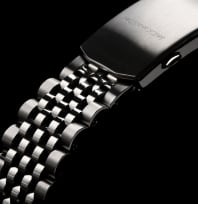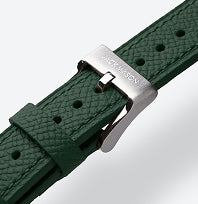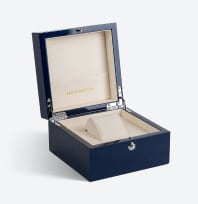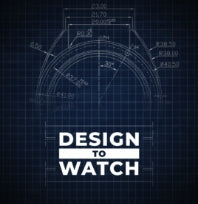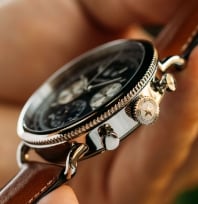What Is A Tachymeter?
A tachymeter is a type of watch complication used to measure the speed at which the watch’s wearer travels over a fixed period of time. Tachymeters are typically featured on chronographs, specialized watches that feature multiple stopwatch functions in addition to the traditional watch display.
A tachymeter is normally a part of a chronograph’s bezel. The bezel is an added component that orbits the face of your watch. Bezels are used to make different types of measurements, and different watches often include different features on their bezels.
Many watch bezels are designed to rotate to make specific measurements and adjustments. For example, many aviation watches feature a dual-time display complication that can be adjusted by rotating the bezel of the watch. However, tachymeters are featured on watches with fixed, non-rotating bezels.
Tachymeters can be used to measure the speed a watch’s wearer is traveling at over a specific period of time. Most tachymeters can make measurements over a period of anywhere from seven to 60 seconds.
Chronograph watches feature a hand that can be started or stopped to make specific measurements. To use the tachymeter complication on your chronograph, you will line up this hand with a specific point on your tachymeter scale. You can then make some quick calculations using a simple formula to determine your speed over a specific period of time.
Tachymeter Measurements Step One: Know The Formula
Making measurements with your tachymeter relies on some basic math. There are 3600 seconds in an hour, and the formula that you use to calculate speed based on your tachymeter reading is T=3600/t. This formula translates the measurement on your tachymeter scale into speed traveled in units per hour by dividing the number of seconds in an hour by the amount of time elapsed on your chronograph.
Knowing this formula means you can calculate your average speed over a certain distance by dividing the amount of time elapsed on your chronograph by the number of seconds in an hour. Based on this formula, you can determine how fast you are traveling from one point to another by starting your chronograph at point A and stopping it at point B. The number on your chronograph is the number of seconds it took to get from point A to point B. The number on your tachymeter is the speed (in miles per hour) you would need to be traveling to reach point B from point A at the speed that you did. That means you now know how fast you were going between point A and point B.
Tachymeter Measurements Step Two: Does Your Watch Have A Tachymeter?
Not all watches, and not even all chronograph watches, include a tachymeter. Tachymeters are often featured on racing watches, whereas the bezel on other specialized types of watches may include another complication. Tachymeters are typically labeled, making them easy to spot.
Another easy way to tell whether or not your watch has a tachymeter is to see if the bezel on your watch rotates. Remember, tachymeters are fixed in place – unlike other complications located on the bezel of a watch, they do not rotate. If your watch has a numeric complication on its bezel that rotates, it is likely a tool other than a tachymeter.
Tachymeter Measurements Step Three: Know The Distance Between Two Points
Tachymeter measurements are based on prior knowledge of the amount of ground you are covering in a fixed period of time. To get an accurate measurement of your speed in miles per hour using your tachymeter, you need to know exactly how far you (or the object you are speed-tracking) have traveled.
The easiest way to get an accurate tachymeter reading is to look for two points with a distance between them that you know. Thanks to smartphones, you can determine the distance between two points with relative ease using a navigation app. Because tachymeters can measure speed over up to 60 seconds, you can track speed over relatively long distances if you are traveling fast enough.
Once you know the distance between points A and B, you are ready to make an accurate tachymeter measurement. All you need now is to start your chronograph at point A and stop it at point B.
Tachymeter Measurements Step Four: Know How To Read Your Chronometer
If you have a chronograph watch with a tachymeter, you need to familiarize yourself with your watch’s chronometer, which plays a key role in tachymeter measurements. Your chronometer serves as the stopwatch function on your watch, with a starting and stopping hand that can be used to track elapsed time. A chronograph has a third hand, which starts spinning when the wearer engages the chronometer using a button on the side of the watch.
The numbers on your chronometer correspond to seconds passed. However, the units on your tachymeter correspond to speed traveled in miles per hour based on your chronometer reading. In other words, you need your chronometer to read your tachymeter.
Once you are familiar with your chronograph’s stopwatch function, you are ready to use it to read the tachymeter on your watch’s bezel. With these two complications working together, you can track the speed of an object over a certain distance.
What Types Of Watches Have Tachymeters?
The main type of watch that includes a tachymeter is the racing watch. Iconic for its sleek design and its place in the rich history of competitive driving, the racing watch is a perfect timepiece for more than just car enthusiasts. Anyone can make good use of the chronometer and tachymeter included on a racing watch to track speeds and times, and these watches are uniquely stylish.
Racing watches are characterized by a few key features. A high-contrast dial is a hallmark of the racing watch design, a must-have feature for drivers traveling at high speeds. Standard watch faces can be difficult to read when moving extremely fast, and the racing watch design has competitive drivers in mind, giving them a highly readable display.
The racing watch design also features a stopwatch function, which can correspond with multiple chronometers for measuring times and distances. In addition to the chronometers, a racing watch includes a tachymeter on its bezel. When used with the stopwatch, the tachymeter can come in handy in many contexts at the racetrack, allowing for the tracking of speeds at certain points in a driver’s route.
A less common complication featured on some racing watches is a pulsometer. This complication is designed for measuring the pulse of a driver. However, the pulsometer is not considered as much of a staple of the racing watch design as the tachymeter or chronometer.
Why You Should Consider A Racing Watch
Racing watches have a unique appeal that reaches far beyond the world of competitive driving. These watches have a number of distinct features that can be useful for anyone measuring times, distances, and speeds. The complications featured on a racing watch make this type of timepiece indispensable for use in a wide variety of competitive sports, from swimming and sprinting to eating contests.
The chronograph has long been relied on in a host of contexts to measure elapsed time. Interacting with a chronograph watch is uniquely satisfying. A well-built watch with useful complications can quickly become not just a favorite accessory but also a highly useful tool that comes in handy in a wide variety of situations. The chronograph on a racing watch can be used in many day-to-day circumstances, and its applications reach beyond the realm of driving and other competitive sports.
In addition to being highly useful, a racing watch has a look that is a unique blend of classic and modern. Jack Mason’s Mirabeau Racing Chronograph has a design that is modeled after components of classic cars from the mid-20th century, making it look like a timeless piece of automotive history that you can proudly wear on your wrist.
The stylish looks and numerous uses of a racing watch make it a worthy candidate for everyday wear. Racing watches can be paired with straps made from a wide variety of materials but tend to look best with a metal or leather band. Using quick-release watch straps, you can easily swap out the strap on a racing watch to transform its appearance. With multiple straps at your disposal, your racing watch can be right at home on a weekend drive, at a formal gathering, at the office, or anywhere else you may find yourself.
The versatile design of the racing watch makes it a jack-of-all-trades that is both stylish and practical. You won’t regret making it a part of your wardrobe, whether you like to drive fast or not. For automotive enthusiasts and casual commuters alike, racing watches have a lot to offer, and their looks and functionality set them apart from other types of timepieces.
Sources:
https://www.artofmanliness.com/articles/use-chronograph-tachymeter-wristwatch/
https://www.caranddriver.com/features/g15376545/the-coolest-racing-watches-ever-made/
https://www.roadandtrack.com/motorsports/a27479488/tag-heuer-motorsport-history/


